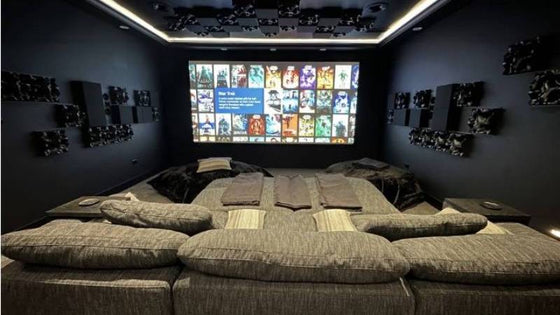Creating a system you love shouldn't be difficult. The Acoustic Frontiers blog is here to help.

Speaker toe-in has a significant effect on the sound – in terms of soundstaging, imaging and tonal balance – and we think it is important to understand some of the facts and data behind why the sound changes when you alter speaker toe.
Altering toe-in fundamentally changes the relationship of the direct and reflected sounds in the room. More toe-in reduces the level of early reflected sounds from the lateral side walls. Less toe-in increases the level of reflections. Toe in also changes the amount of high frequency energy above about 4kHz in the direct sound.
When you listen in a home recording studio, home theater or stereo listening room what you perceive as sound is a combination of many things. We can conceptually break down the sonic contributors into three parts:
For definitions and more discussion see our article speaker off axis response: psychoacoustic and subjective importance.
A speaker that is fully toed-in is one that points directly at the listening position. The direct sound is therefore described by the 0 degree, on axis frequency response. The on axis sound generally contains the most high frequency energy. All speakers except omnidirectionals have decreasing high frequency energy as you move off axis.

In the hypothetical room shown above the first lateral side wall reflection will be at 86 degrees. Note that this angle will vary from room-to-room, but is nearly always above 70 degrees. This is significantly off axis, and most speakers will have a distinctly non-flat response at this off axis angle.
An overly simplistic way to look at the psychoacoustic effect of reflections would be to simply add the direct and reflected sound together. Your brain does something like this but it is not a straight mathematical addition. It gives some clues however as to what is going on inside the brain.
The vast majority of speakers show a tapering off in high frequency energy above about 4kHz as the tweeter becomes directional. This is because the tweeter starts to get acoustically large relative to the wavelengths being reproduced. The exact frequency at which the response starts tapering off is therefore mathematically related to the acoustical size of the driver (see here for more discussion on this).

Frequency response measurements at 0 degrees (on axis) and 90 degrees. These are very similar off axis angles as the example presented above for a speaker toed-in directly at the listening position. Measurements taken from the ATC SCM19 speaker. The A+B trace shows the 0 and 90 degree traces added together…and you can see the slowly decreasing dispersion as frequency increases.
You can see that the frequency response of the combined direct + reflected response is very close to that of the direct response by itself. The direct sound is significantly higher in level than the reflected sound, showing that the reflected sound is not that important in terms of what you hear. Also note that the reflected sound contains less high frequency energy than the direct sound above 5kHz.
Some loudspeaker designers expressly design around a non-flat on axis response. Often they design in a rising high frequency response, the idea being that this accounts for tweeter directionality and provides a flatter response at the listening position.
Take a look at the response below, from a Dynaudio speaker. Listened to on axis (0 degrees), this would be a very “bright” speaker! Presumably a better angle to listen to this speaker at would be around 45 degrees off axis.

Speaker lateral off axis response, Dynaudio Confidence C4.
When the speaker is pointed straight ahead there is actually much more of a similarity in the level of the direct and reflected sounds. Psychoacoustically this will increase the width of the soundstage.

For a wide dispersion speaker the response at 30 and 60 degrees off axis will be virtually identical through the midrange up to the point at which the tweeter starts becoming directional. This is clearly shown in the example response below.

Response at 23 and 68 degrees off axis for an ATC SCM19.
In this example the combined response of the direct and reflected sounds is significantly higher than either individual response. The reflection is much higher in level than when the speaker is pointed straight ahead and so will be more psychoacoustically significant.
It’s important to realize that reflections are not necessarily bad. There is a lot of research (collated in places like Floyd Toole’s Sound Reproduction book) that shows people like strong lateral reflections, as they increase perceived soundstage width and envelopment.
The problem with speakers that have a rising on axis response is that you have to point them straight ahead if you do not want an excessively bright sound, and so have to deal with the lateral side wall reflection being higher in level. Speakers designed around a flat on axis response give you more choices.
When you toe-in a loudspeaker you are altering:
Learn how early home theater design, layout, and acoustic treatment improve performance in new home construction.
This media room was intentionally designed to feel like part of the home—not a separate, tech-heavy space. Through careful acoustic planning, equipment integration, and final calibration, we achieved a room that is both beautiful to live in and immersive to experience.
"No other subwoofer system I’ve owned even comes close to what this room delivers. Reaching out to Acoustic Frontiers was one of the best decisions I’ve made—I highly recommend working with them if you want to get the most out of your theater."

Nyal Mellor, Founder, Acoustic Frontiers



Nyal Mellor
Author